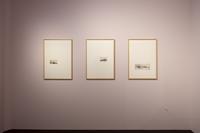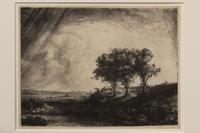Chapter 5IVE
Landscape with a Boundary, 1650
Landscape with Trees, Farms and a Tower, 1650
Landscape with Square Tower, 1650
View of Amsterdam from the Northwest, 1638–42
The Three Trees, 1643
Landscape with a Cottage and a Hay Barn, 1641
Cottages and a hay barn on the Diemerdijk with a flock of sheep, 1652
Landscape with Three Cottages along a Road, 1650
A loan from Amsterdam Museum
CHAPTER 5IVE opens with a series of eight etchings by Rembrandt, made between 1638 and 1652. They show the countryside around Amsterdam in the seventeenth century with an impetuousness that you rarely encounter nowadays. Wild bushes shoot up along gurgling brooks and streams. Between ramshackle cottages you sometimes discover a hiker, a farmer’s wife staring outside through the doorway, or even a draughtsman on a hill, staring into the distance. And in the background the city’s skyline, which helps to identify the places they depict almost accurately. You would think the etchings give an impression of what the area around Amsterdam looked like in Rembrandt’s time. But interestingly, Rembrandt chooses not to depict new developments in the landscape – a choice he shares with many other landscape painters at the time. In the period between 1612 and 1635, an exceptionally large area around Amsterdam was drained; marshes and lakes gave way to extraordinarily flat, rhythmic meadows with perfectly straight canals. The contemporary and commercially exploited landscape with busy water-ways, windmills to drain the land and various kinds of entrepreneurial activities did not find its way into the images Rembrandt made. Instead, we see a dramatic fantasy landscape with romantic hill slopes and the occasional lonely traveller. During his lifetime, Rembrandt was better known for his etchings than for his paintings. It is a possibility that his nostalgic depictions of the landscape – devoid of the impact of contemporary activities – helped his contemporaries to better relate to the drastic transformations that they were experienced themselves during their lifetime.

